1987 MAZDA 626 Rear brakes
[x] Cancel search: Rear brakesPage 10 of 1865
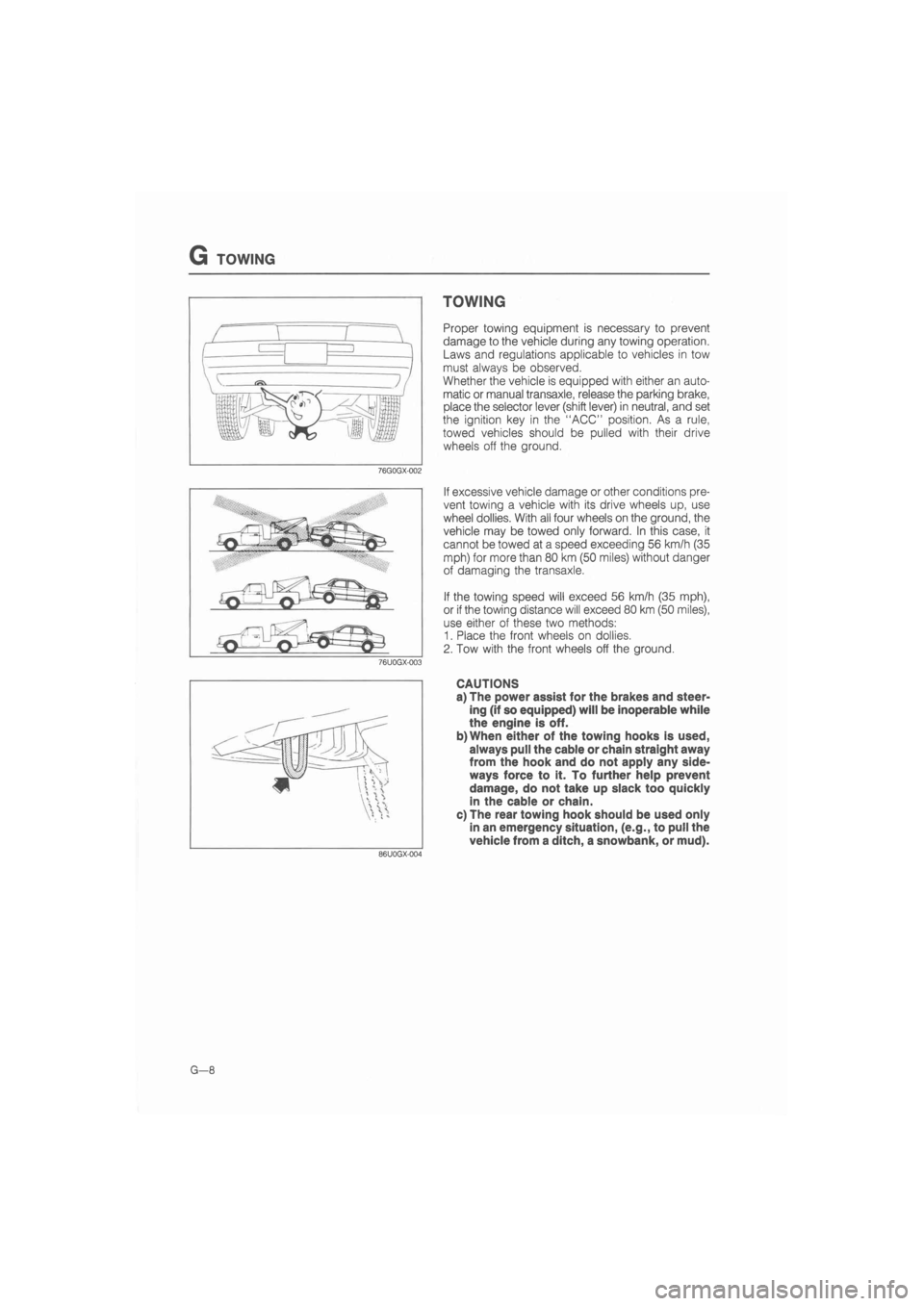
G TOWING
76GOGX-OQ2
i-^C.
y -
- r^jfftj&H
r —I
76UQGX-003
86U0GX-004
G—8
TOWING
Proper towing equipment is necessary to prevent
damage to the vehicle during any towing operation.
Laws and regulations applicable to vehicles in tow
must always be observed.
Whether the vehicle is equipped with either an auto-
matic or manual transaxle, release the parking brake,
place the selector lever (shift lever) in neutral, and set
the ignition key in the "ACC" position. As a rule,
towed vehicles should be pulled with their drive
wheels off the ground.
If excessive vehicle damage or other conditions pre-
vent towing a vehicle with its drive wheels up, use
wheel dollies. With all four wheels on the ground, the
vehicle may be towed only forward. In this case, it
cannot be towed at a speed exceeding 56 km/h (35
mph) for more than 80 km (50 miles) without danger
of damaging the transaxle.
If the towing speed will exceed 56 km/h (35 mph),
or if the towing distance will exceed 80 km (50 miles),
use either of these two methods:
1. Place the front wheels on dollies.
2. Tow with the front wheels off the ground.
CAUTIONS
a) The power assist for the brakes and steer-
ing (if so equipped) will be inoperable while
the engine is off.
b)When either of the towing hooks is used,
always pull the cable or chain straight away
from the hook and do not apply any side-
ways force to it. To further help prevent
damage, do not take up slack too quickly
in the cable or chain.
c) The rear towing hook should be used only
in an emergency situation, (e.g., to pull the
vehicle from a ditch, a snowbank, or mud).
Page 19 of 1865
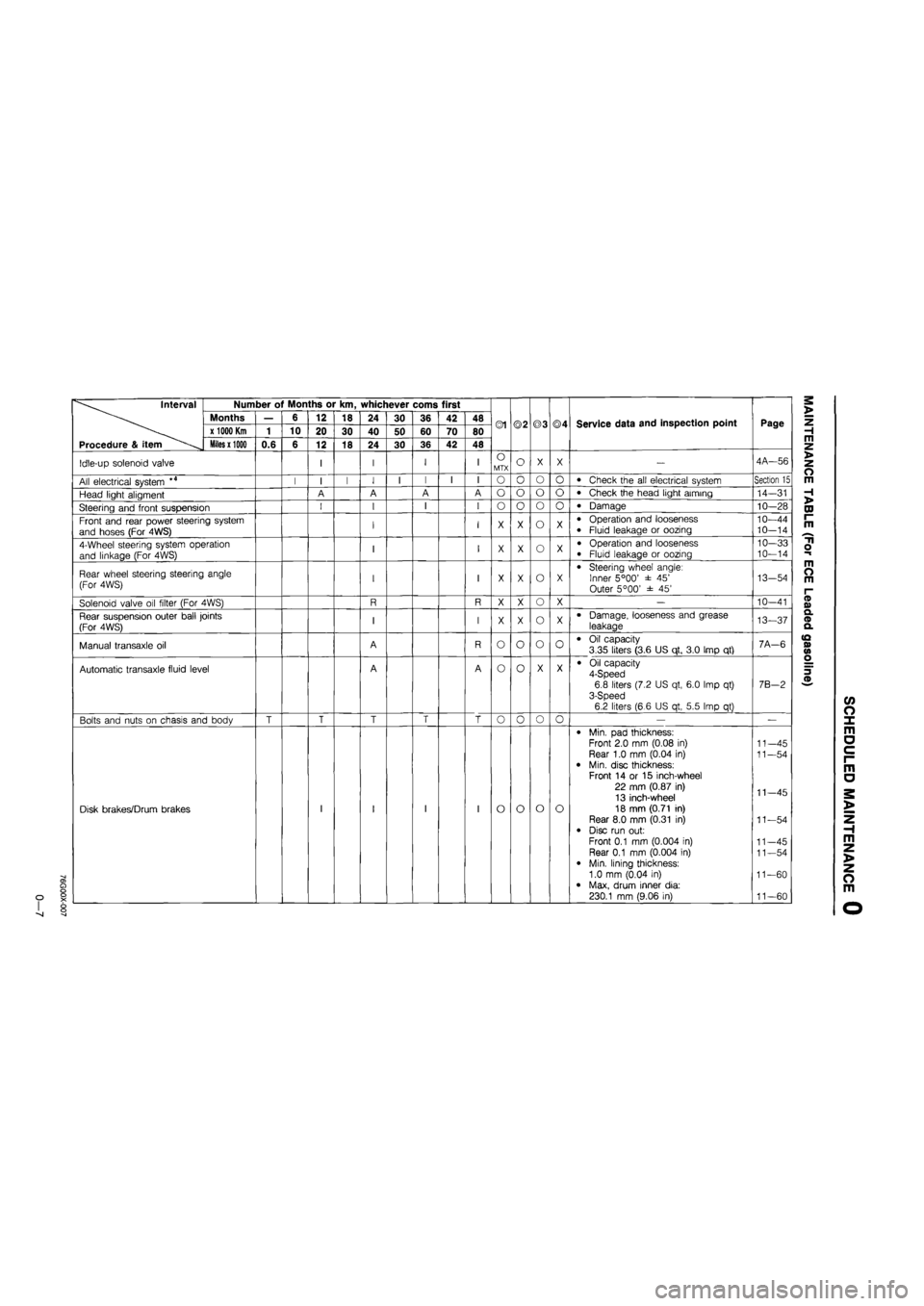
Interval
Procedure & item
Number of Months or km, whichever corns first
©1 ©2 ©3 ©4 Service data and inspection point Page
Interval
Procedure & item
Months — 6 12 18 24 30 36 42 48 ©1 ©2 ©3 ©4 Service data and inspection point Page
Interval
Procedure & item
x 1000 Km 1 10 20 30 40 50 60 70 80 ©1 ©2 ©3 ©4 Service data and inspection point Page
Interval
Procedure & item Miles x 1000 0.6 6 12 18 24 30 36 42 48
©1 ©2 ©3 ©4 Service data and inspection point Page
Idle-up solenoid valve I I I I O MTX o X X — 4A—56
All electrical system *4 I I I I I I I I o o o o • Check the all electrical system Section 15
Head light aligment A A A A o o o o • Check the head light aiming 14-31
Steering and front suspension I I I I o o o 0 • Damage 10—28
Front and rear power steering system
and hoses (For 4WS) I I X X o X • Operation and looseness • Fluid leakage or oozing 10—44 10—14
4-Wheel steering system operation
and linkage (For 4WS) I I X X o X • Operation and looseness
• Fluid leakage or oozing
10—33 10—14
Rear wheel steering steering angle
(For 4WS) I I X X o X • Steering wheel angle: Inner 5°00' ± 45' Outer 5°00' ± 45'
13-54
Solenoid valve oil filter (For 4WS) R R X X o X — 10-41
Rear suspension outer ball joints
(For 4WS) I I X X o X • Damage, looseness and grease
leakage 13—37
Manual transaxle oil A R o o o 0 • Oil capacity 3.35 liters (3.6 US qt, 3.0 Imp qt) 7A-6
Automatic transaxle fluid level A A o o X X • Oil capacity 4-Speed 6.8 liters (7.2 US qt, 6.0 Imp qt) 3-Speed 6.2 liters (6.6 US qt, 5.5 Imp qt)
7B-2
Bolts and nuts on chasis and body T T T T T o o o o — —
Disk brakes/Drum brakes I I I I o o o o
• Min. pad thickness: Front 2.0 mm (0.08 in) Rear 1.0 mm (0.04 in) • Min. disc thickness: Front 14 or 15 inch-wheel
22 mm (0.87 in) 13 inch-wheel 18 mm (0.71 in) Rear 8.0 mm (0.31 in)
• Disc run out:
Front 0.1 mm (0.004 in) Rear 0.1 mm (0.004 in)
• Min. lining thickness: 1.0 mm (0.04 in) • Max, drum inner dia: 230.1 mm (9.06 in)
11—45
11—54
11—45
11—54
11-45 11—54
11-60
11—60
Page 31 of 1865

CD
o> O o o X o
Interval
Procedure & item
Number of Months or km, whichever corns first
©1 ©2 ©3 ©4 Service data and inspection point Page
Interval
Procedure & item
Months — 6 12 18 24 30 36 42 48 ©1 ©2 ©3 ©4 Service data and inspection point Page
Interval
Procedure & item
x 1000 Km
1 10 20 30 40 50 60 70 80 ©1 ©2 ©3 ©4 Service data and inspection point Page
Interval
Procedure & item
Miles x 1000
0.6 6 12 18 24 30 36 42 48
©1 ©2 ©3 ©4 Service data and inspection point Page
Idle mixture (1) only for carbretor (I) I I I I O O o X
• CO concentration 2.0 ± 0.5 % CO concentration FE DOHC 1.5 ± 0.5 % HC concentration FE DOHC Less than 1000 rpm
4A-38
4C-30
Evaporative system
(only for middle east) I I I I X O X X — 4A—78
Dashpot (only for MTX) I I I I o X X X • Operation 4A—50
Coasting leaner system *6 t I I I
,
O X X X — 4A-56
Brake lines, hoses and connections I I I I o o o o • Proper attachment and connections 11-8
Disc brakes [ I I I I [ I I o o o o
• Min. pad thickness: Front 2.0 mm (0.08 in) Rear 1.0 mm (0.04 in)
• Min. disc thickness: Front 14 or 15 inch-wheel 22 mm (0.87 in)
13 inch-whel 18 mm (0.71 in) Rear 8.0 mm (0.31 in) • Disc run out: Front 0.1 mm (0.004 in) Rear 0.1 mm (0.004 in)
11—45 11—54
11—45
11—54
11—45
11—54
Drum brakes I I I I o o X o
• Min. lining thickness: 1.0 mm (0.004 in)
• Max. drum inner dia: 14 or 15 inch-wheel 230.1 mm (9.06 in) 13 inch-wheel 201.5 mm (7.93 in)
11-60
11—60
Steering linkages, rack guide and tie
rod ends I I I I I o o o o • Operation and looseness 10-11
Manual transaxle oil R o o 0 o • Oil capacity
3.35 liters (3.6 US qt, 3.0 Imp qt) 7A—6
Automatic transaxle fluid level I I I I o o X X
• Oil capacity 4-Speed 6.8 liters (7.2 US qt, 6.0 Imp qt) 3-Speed 6.2 liters (6.6 US qt, 5.5 Imp qt)
7B—71
7C-25
m z >
o m
H >
CO I-m
"ti o
a
Page 1396 of 1865

1 1 OUTLINE
SPECIFICATIONS
Item Specification
Brake pedal
Type Suspended
Brake pedal Pedal lever ratio 4.2 Brake pedal
Max. stroke mm (in) LHD: 136.5 (5.37) RHD: 135 (5.31)
Master cylinder Type Tandem (with level sensor) Master cylinder
Cylinder inner diameter mm (in) 22.22 (0.87)
Front disc brake
Type Mounting support, Ventilated disc
Front disc brake
Cylinder bore mm (in) 53.97 (2.12)
Front disc brake Pad dimensions (area x thickness) mm2 x mm (in2 x in) 4,800 x 10 (7.44 x 0.39) Front disc brake
Disc plate dimensions mm (in) (outer diameter x thickness) 13 inch-wheel: 242 x 20 (9.53 x 0.79) 14 or 15 inch-wheel: 264 x 24 (10.39 x 0.94)
Rear disc brake
(Turbo model)
Type Mounting support, Solid disc
Rear disc brake
(Turbo model)
Cylinder bore mm (in) 30.2 (1.19)
Rear disc brake
(Turbo model) Pad dimensions (area x thickness) mm2 x mm (in2 x in) 2,900 x 8 (4.5 x 0.31)
Rear disc brake
(Turbo model)
Disc plate dimensions mm (in) (outer diameter x thickness) 259 x 10 (10.2 x 0.39)
Rear drum brake
(Non-Turbo model)
Type Leading-trailing
Rear drum brake
(Non-Turbo model)
Wheel cylinder inner diameter mm (in) 17.46 (0.69)
Rear drum brake
(Non-Turbo model) Lining dimensions mm (in)
(width x length x thickness) (a): 25 x 191.9 x 5 (0.98 x 7.56 x 0.20)
(b): 30 x 219.3 x 5 (1.18 x 8.63 x 0.20)
Rear drum brake
(Non-Turbo model)
Drum inner diameter mm (in) (a): 200.0 (7.87) (b): 228.6 (9.0)
Rear drum brake
(Non-Turbo model)
Shoe clearance adjustment Automatic adjuster
Power brake unit Type Vacuum multiplier Power brake unit
Diameter mm (in) 238 (9.37)
Braking force control device Type Dual proportioning valve or ABS (if equipped)
Brake fluid DOT-3 or DOT-4, or SAE J1703
Parking brake Type Center lever (Mechanical two rear brakes)
(a)...13-inch wheel in General LHD and RHD models
(b)...Except 13-inch wheel in General LHD and RHD models
11-4
Page 1404 of 1865
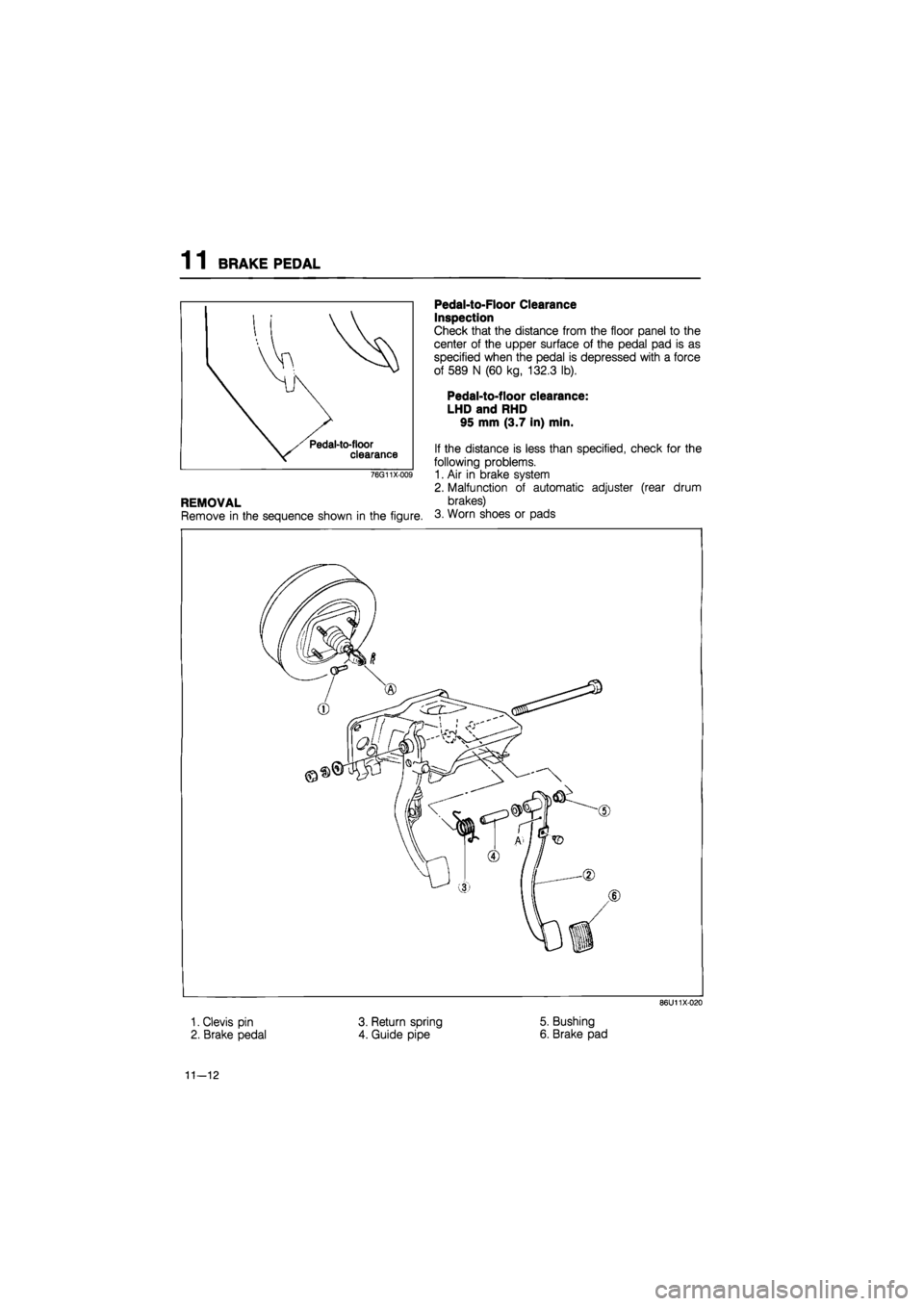
1 1 BRAKE PEDAL
Pedal-to-floor clearance
76G11X-009
REMOVAL
Remove in the sequence shown in the figure.
Pedal-to-Floor Clearance
Inspection
Check that the distance from the floor panel to the
center of the upper surface of the pedal pad is as
specified when the pedal is depressed with a force
of 589 N (60 kg, 132.3 lb).
Pedal-to-floor clearance:
LHD and RHD
95 mm (3.7 in) min.
If the distance is less than specified, check for the
following problems.
1. Air in brake system
2. Malfunction of automatic adjuster (rear drum
brakes)
3. Worn shoes or pads
86U11X-020
1. Clevis pin
2. Brake pedal
3. Return spring
4. Guide pipe
5. Bushing
6. Brake pad
11—12
Page 1439 of 1865
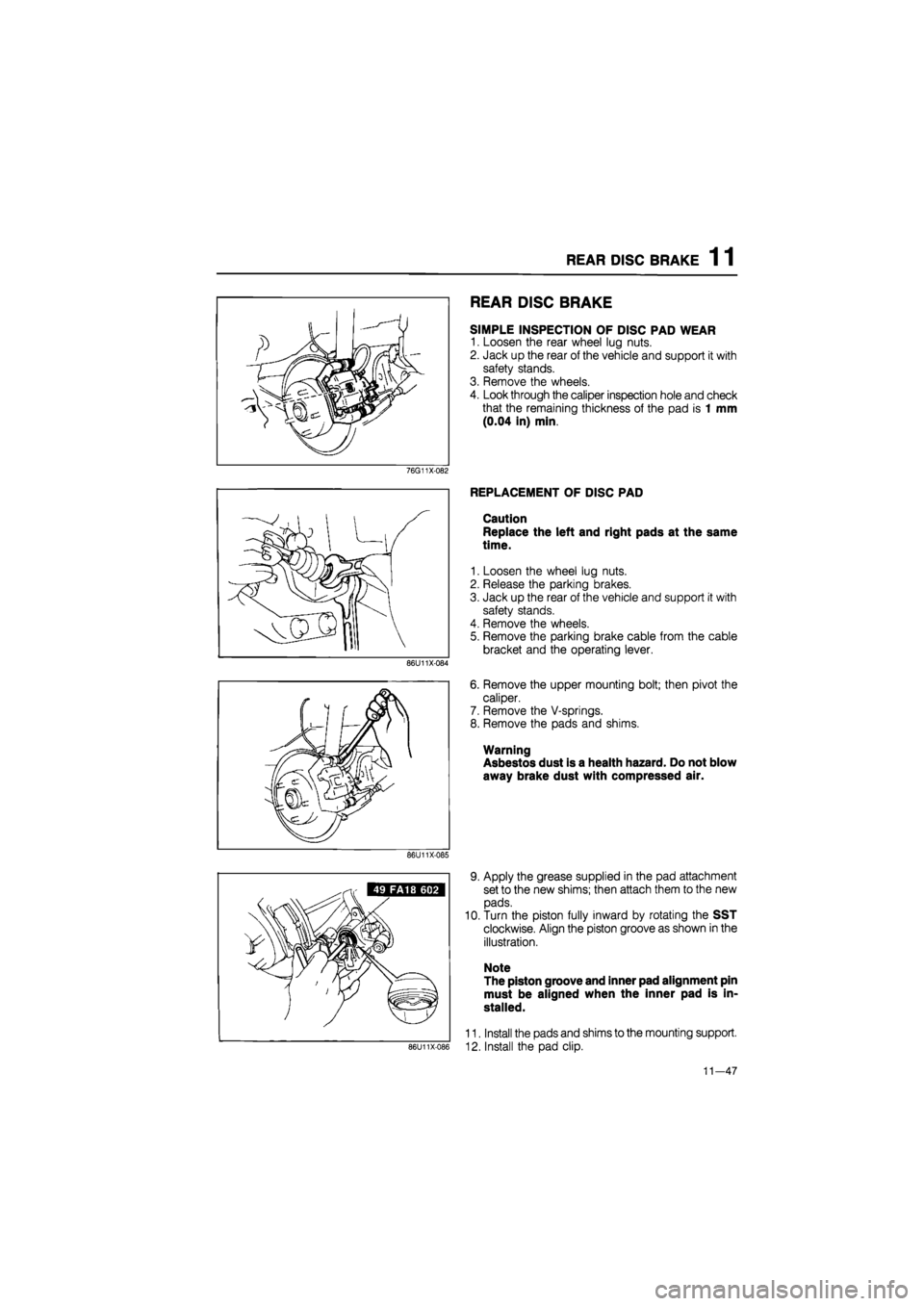
REAR DISC BRAKE 1 1
REAR DISC BRAKE
SIMPLE INSPECTION OF DISC PAD WEAR
1. Loosen the rear wheel lug nuts.
2. Jack up the rear of the vehicle and support it with
safety stands.
3. Remove the wheels.
4. Look through the caliper inspection hole and check
that the remaining thickness of the pad is 1 mm
(0.04 in) min.
76G11X-082
86U11X-084
REPLACEMENT OF DISC PAD
Caution
Replace the left and right pads at the same
time.
1. Loosen the wheel lug nuts.
2. Release the parking brakes.
3. Jack up the rear of the vehicle and support it with
safety stands.
4. Remove the wheels.
5. Remove the parking brake cable from the cable
bracket and the operating lever.
6. Remove the upper mounting bolt; then pivot the
caliper.
7. Remove the V-springs.
8. Remove the pads and shims.
Warning
Asbestos dust is a health hazard. Do not blow
away brake dust with compressed air.
86U11X-085
86U11X-086
9. Apply the grease supplied in the pad attachment
set to the new shims; then attach them to the new
pads.
10. Turn the piston fully inward by rotating the SST
clockwise. Align the piston groove as shown in the
illustration.
Note
The piston groove and inner pad alignment pin
must be aligned when the inner pad is in-
stalled.
11. Install the pads and shims to the mounting support.
12. Install the pad clip.
11—47
Page 1440 of 1865
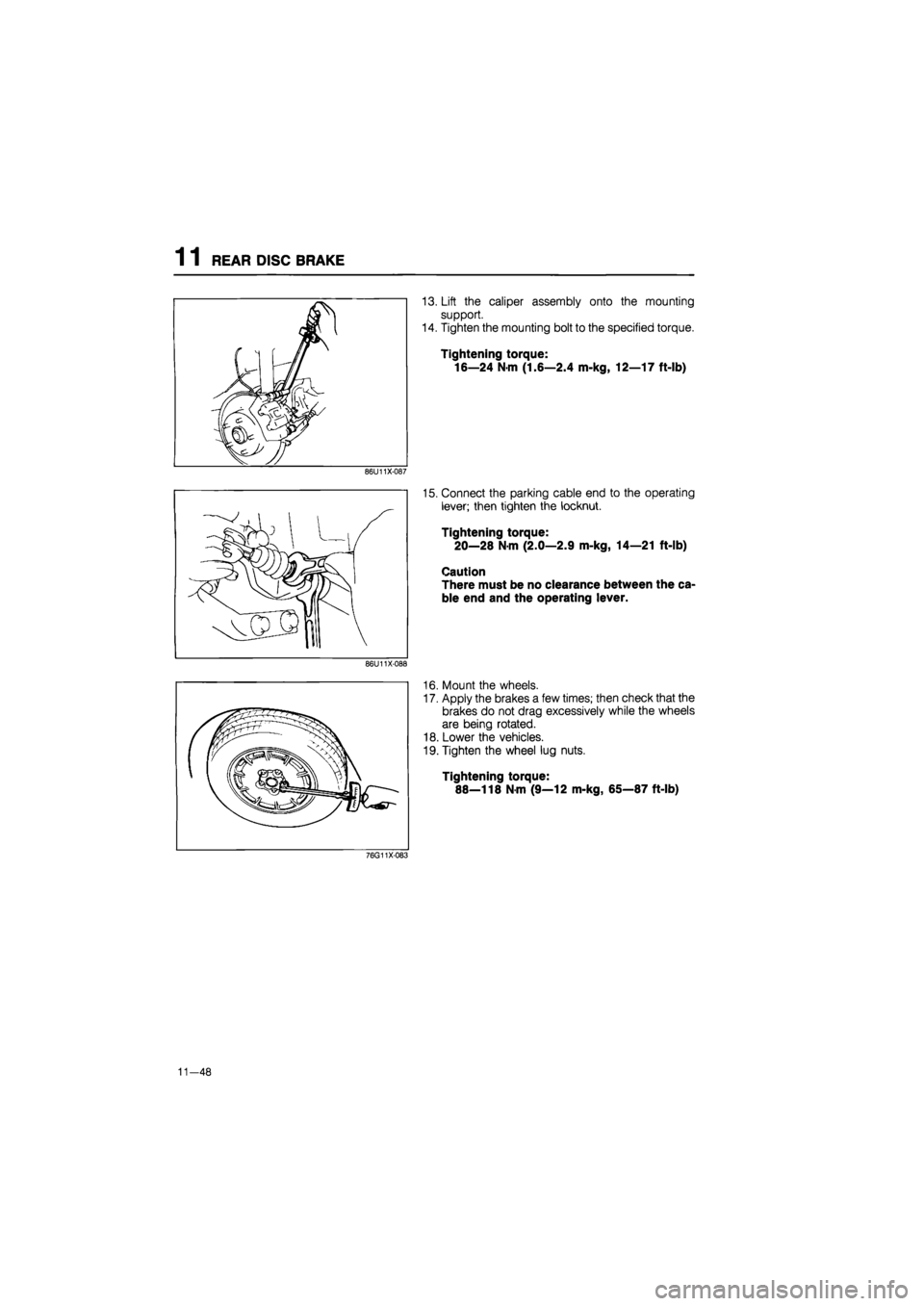
1 1 REAR DISC BRAKE
86U11X-087
86U11X-088
13. Lift the caliper assembly onto the mounting
support.
14. Tighten the mounting bolt to the specified torque.
Tightening torque:
16—24 Nm (1.6—2.4 m-kg, 12—17 ft-lb)
15. Connect the parking cable end to the operating
lever; then tighten the locknut.
Tightening torque:
20—28 N-m (2.0—2.9 m-kg, 14—21 ft-lb)
Caution
There must be no clearance between the ca-
ble end and the operating lever.
16. Mount the wheels.
17. Apply the brakes a few times; then check that the
brakes do not drag excessively while the wheels
are being rotated.
18. Lower the vehicles.
19. Tighten the wheel lug nuts.
Tightening torque:
88—118
N
m (9—12 m-kg, 65—87 ft-lb)
76G11X-083
11-48
Page 1441 of 1865
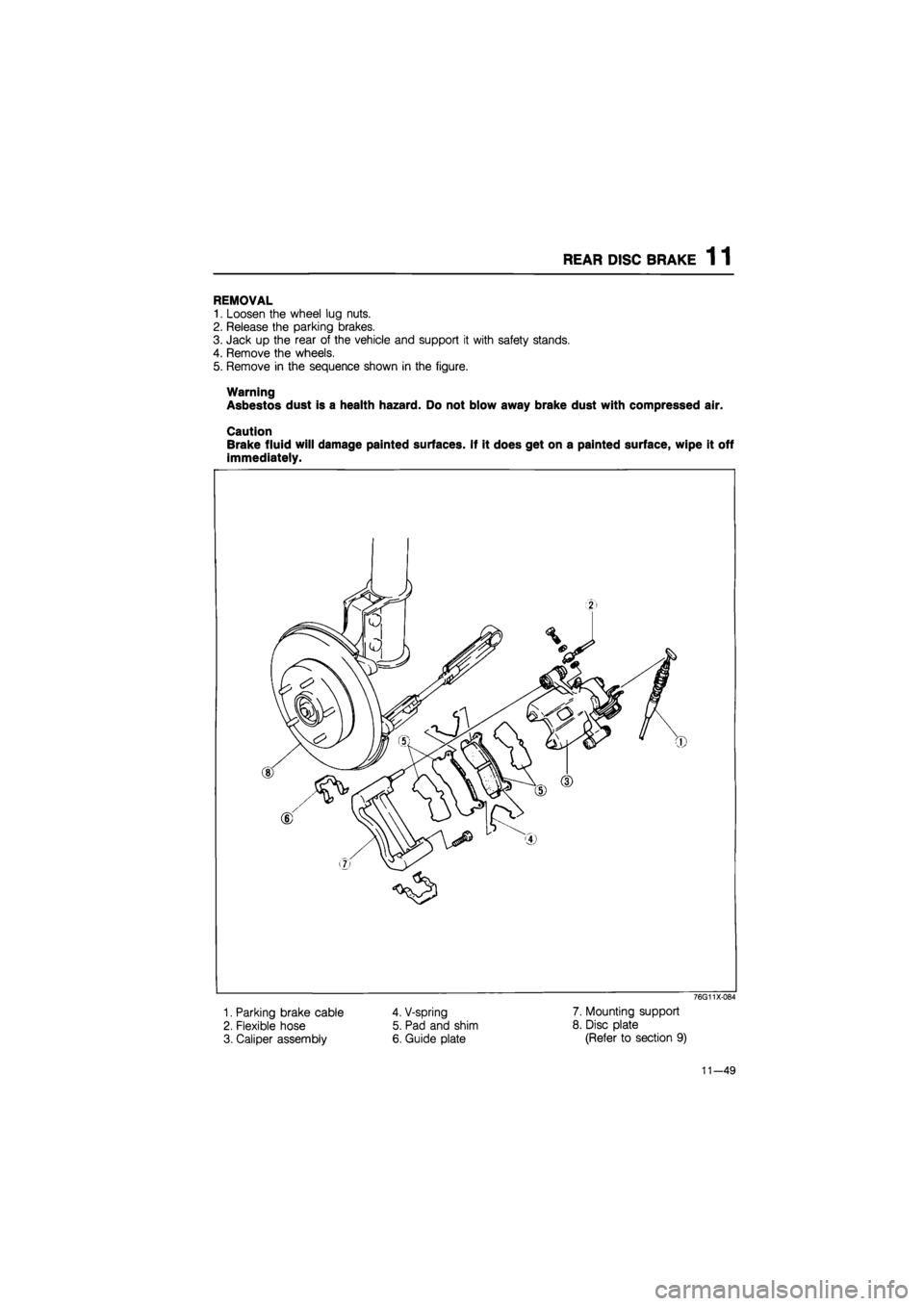
REAR DISC BRAKE 1 1
REMOVAL
1. Loosen the wheel lug nuts.
2. Release the parking brakes.
3. Jack up the rear of the vehicle and support it with safety stands.
4. Remove the wheels.
5. Remove in the sequence shown in the figure.
Warning Asbestos dust is a health hazard. Do not blow away brake dust with compressed air.
Caution
Brake fluid will damage painted surfaces. If it does get on a painted surface, wipe it off
immediately.
76G11X-084
1. Parking brake cable
2. Flexible hose
3. Caliper assembly
4. V-spring
5. Pad and shim
6. Guide plate
7. Mounting support
8. Disc plate
(Refer to section 9)
11—49